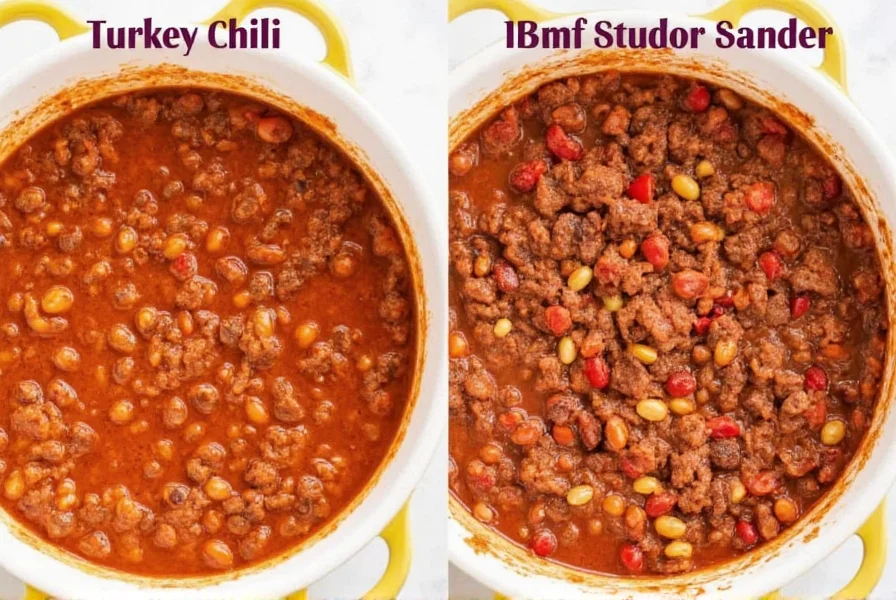Understanding the precise calorie content of turkey chili is essential for those tracking their nutritional intake. Whether you're meal prepping, managing weight, or simply making healthier food choices, knowing what's in your bowl matters. This comprehensive guide breaks down the nutritional profile of turkey chili, explains what factors affect its calorie count, and shows how it compares to other chili varieties.
What Determines Turkey Chili's Calorie Count?
The calorie content in turkey chili isn't fixed—it changes based on several key factors. Unlike pre-packaged foods with standardized nutrition labels, homemade chili recipes vary widely in their nutritional profile.
| Ingredient | Calories per 100g | Impact on Total |
|---|---|---|
| Lean ground turkey (93% lean) | 130 | Primary contributor (60-70% of total) |
| Beans (kidney or black) | 80-100 | Moderate contributor (15-20%) |
| Vegetables (onions, peppers, tomatoes) | 20-30 | Minor contributor (5-10%) |
| Oil/fat for cooking | 900 | Variable (5-15% depending on amount used) |
The cooking method significantly impacts the final calorie count. Recipes that brown the turkey in minimal oil and drain excess fat yield substantially fewer calories than those using generous amounts of cooking fat. Similarly, adding cheese, sour cream, or other toppings at serving time can dramatically increase the calorie content beyond the base chili.
Detailed Nutritional Breakdown
Beyond just calories, turkey chili offers a balanced nutritional profile that makes it a smart choice for health-conscious eaters. A typical 1-cup serving provides:
- Protein: 25-30g (excellent source for muscle maintenance)
- Fat: 8-12g (mostly unsaturated when prepared properly)
- Carbohydrates: 25-30g (primarily from beans and vegetables)
- Fiber: 8-10g (nearly 40% of daily recommended intake)
- Sodium: 400-600mg (varies significantly by recipe)
The high protein and fiber content creates a powerful combination for satiety, helping you feel full longer than many other meal options with similar calorie counts. This makes turkey chili particularly valuable for weight management strategies.
Turkey Chili vs. Beef Chili: A Calorie Comparison
One of the primary reasons people choose turkey over beef for chili is the significant difference in calorie and fat content. Understanding these differences helps make informed dietary choices.
| Nutrient | Lean Turkey Chili (1 cup) | Regular Beef Chili (1 cup) | Difference |
|---|---|---|---|
| Calories | 280-320 | 350-420 | 70-100 fewer |
| Total Fat | 8-12g | 18-24g | 10-12g less |
| Saturated Fat | 2-3g | 6-8g | 4-5g less |
| Protein | 25-30g | 22-26g | 3-4g more |
This comparison clearly shows why turkey chili calories are a preferred option for those watching their fat intake while maintaining high protein consumption. The leaner protein source in turkey chili directly contributes to its lower overall calorie count without sacrificing nutritional value.

Recipe Variations and Their Calorie Impact
Not all turkey chili recipes are created equal when it comes to calorie content. Small modifications can significantly alter the nutritional profile:
- White bean turkey chili: Substituting white beans for kidney beans reduces calories slightly (about 20 fewer per serving) while maintaining protein content
- Veggie-packed version: Adding extra vegetables like zucchini, carrots, or corn increases volume with minimal calorie addition, effectively reducing calories per bite
- Crockpot turkey chili: Slow cooking often requires less added fat, potentially saving 30-50 calories per serving
- Spicy turkey chili: Adding heat through peppers rather than fatty ingredients maintains low calorie count while boosting flavor
For those specifically tracking calories in turkey chili per serving, consider these adjustments to create a lower-calorie version:
- Use 99% lean ground turkey instead of 93% lean
- Replace half the meat with additional beans or lentils
- Cook with cooking spray instead of oil
- Add vegetable broth to increase volume without adding calories
- Use tomato-based rather than cream-based ingredients
Maximizing Health Benefits While Managing Calories
Turkey chili's nutritional advantages extend beyond just the base turkey chili nutrition facts. Strategic preparation enhances its health profile:
Research shows that the combination of lean protein and high fiber in properly prepared turkey chili creates a low glycemic index meal, helping maintain stable blood sugar levels. The capsaicin in chili peppers may also provide a slight metabolic boost, though this effect is modest.
When considering how many calories in homemade turkey chili you're consuming, remember that the health benefits come from the complete nutritional package, not just the calorie count. The vitamins, minerals, and antioxidants from the vegetables and spices contribute to overall wellness in ways that extend beyond simple calorie accounting.
Serving Strategies for Calorie-Conscious Eaters
Even with its relatively modest calorie count, portion control remains important. Here are practical strategies:
- Measure servings with a standard measuring cup rather than eyeballing
- Pair with a side salad instead of cornbread to reduce overall meal calories
- Use Greek yogurt instead of sour cream as a topping (saves 50+ calories)
- Add extra vegetables to increase portion size without significantly increasing calories
- Store individual portions in containers for easy grab-and-go meals
For those specifically interested in turkey vs beef chili calories, the difference becomes even more pronounced when considering typical serving sizes. Many people serve larger portions of turkey chili because it's perceived as healthier, potentially negating the calorie advantage if portions grow by 25-30%.
Frequently Asked Questions
How many calories are in a cup of turkey chili with beans?
A standard 1-cup serving of turkey chili with beans typically contains 280-320 calories. The beans contribute approximately 80-100 calories per 100g, while the lean turkey provides the majority of the remaining calories. This makes bean-inclusive turkey chili slightly higher in carbohydrates but also higher in fiber than versions without beans.
Is turkey chili good for weight loss?
Yes, turkey chili can be an excellent addition to a weight loss diet when prepared properly. Its high protein (25-30g per serving) and fiber content (8-10g) promote satiety, helping you feel full longer. With approximately 280-320 calories per cup—70-100 calories less than beef chili—it provides a satisfying meal within reasonable calorie limits. For best results, control portion sizes and avoid high-calorie toppings.
How can I make lower calorie turkey chili?
To reduce calories in turkey chili: use 99% lean ground turkey, replace half the meat with additional beans or lentils, cook with cooking spray instead of oil, add vegetable broth to increase volume, and load up on non-starchy vegetables like bell peppers and zucchini. These modifications can reduce the calorie count to approximately 220-250 per serving while maintaining flavor and nutritional value.
Does turkey chili have more protein than beef chili?
Yes, turkey chili typically contains slightly more protein than beef chili—about 25-30g per serving compared to 22-26g in beef chili. This is because lean ground turkey has a higher protein-to-fat ratio than even lean ground beef. The protein content makes turkey chili particularly valuable for those seeking high-protein, moderate-calorie meal options.
How do toppings affect turkey chili calories?
Toppings can significantly impact the total calorie count of your turkey chili. A tablespoon of sour cream adds approximately 30 calories, shredded cheese adds 40-50 calories, and avocado adds about 50 calories per 1/4 fruit. For a lower-calorie option, use Greek yogurt instead of sour cream (saves 15-20 calories per tablespoon) and limit high-fat toppings to small portions to keep your total meal calories in check.











 浙公网安备
33010002000092号
浙公网安备
33010002000092号 浙B2-20120091-4
浙B2-20120091-4